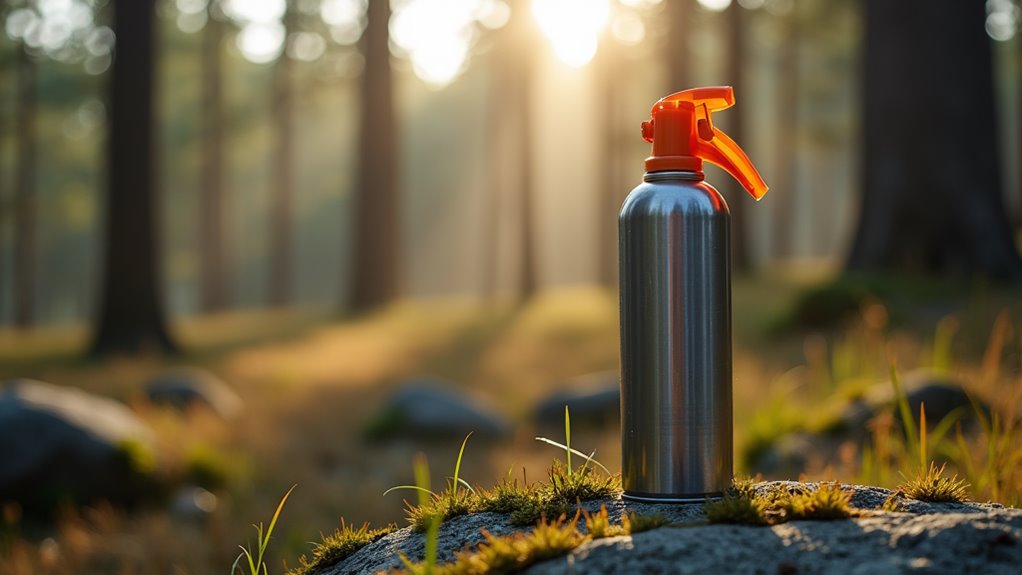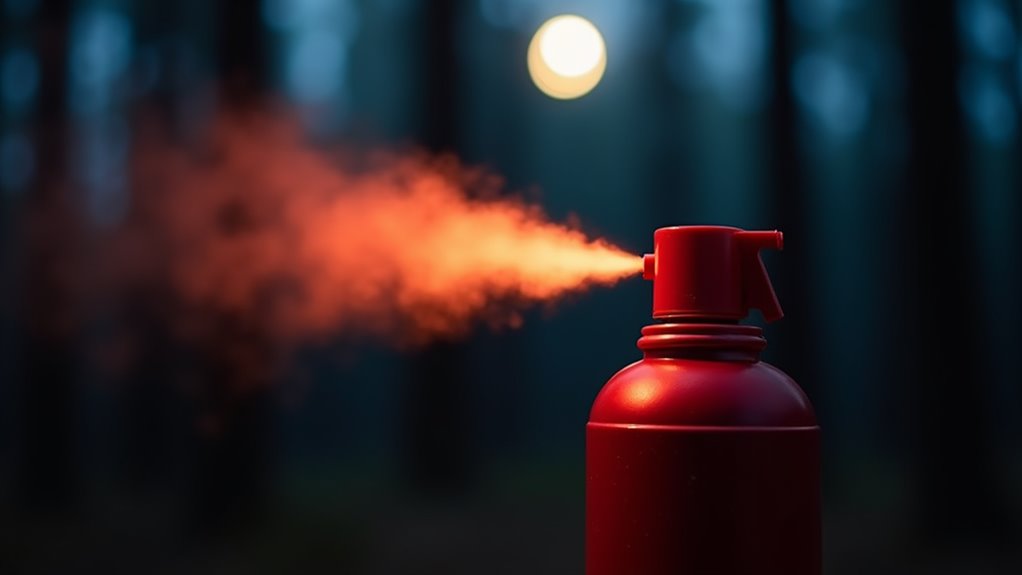You can safely use pepper spray as a non-lethal deterrent against aggressive animals during outdoor activities. It’s legal for self-defense and creates a temporary inflammatory response in an animal’s eyes, nose, and throat without causing permanent harm. Keep your spray in an easily accessible holster, check expiration dates regularly, and guarantee it’s functional in various weather conditions. Proper storage and handling will help you stay prepared for unexpected wildlife encounters. Learn essential tips to maximize your safety outdoors.
Legal for Self-Defense Outdoors

When you’re heading into the outdoors, you’ll be glad to know that pepper spray offers a non-lethal way to protect yourself from aggressive animals without causing permanent harm. The small size and lightweight design of pepper spray makes it easy to clip onto your backpack or belt loop, ensuring you’re always prepared for unexpected animal encounters on the trail. Even in challenging weather conditions like rain or wind, pepper spray remains an effective deterrent that can give you precious time to retreat to safety, as its powerful formula will still affect an animal’s sensitive nose and eyes. The Grizguard Bear Spray is an example of a highly effective option, with a range of up to 30 ft and a dispersal design that ensures rapid deployment. Guard Alaska Bear Spray is another example of a highly effective option, with a range of up to 20 ft and a dispersal design that ensures rapid deployment.
Non-Lethal Deterrent Option
Although many hikers and outdoor enthusiasts prefer to avoid animal encounters altogether, pepper spray serves as a highly effective, non-lethal option for self-defense in the wilderness.
When you’re faced with aggressive animal behavior, having pepper spray readily available can mean the difference between a dangerous encounter and a safe escape.
Unlike firearms or other weapons, pepper spray won’t cause permanent harm to the animal while still providing you with vital protection.
You’ll want to take proper safety precautions, like storing the spray in an easily accessible holster and checking its expiration date regularly.
The spray creates a temporary inflammatory response in the animal’s eyes, nose, and throat, giving you precious time to retreat to safety.
It’s an ethical choice that lets you protect yourself while respecting wildlife.
Compact and Easy to Carry
The compact size of pepper spray makes it an ideal companion for outdoor activities, fitting easily into most pockets, backpack compartments, or belt holsters.
You’ll find that most canisters are about the size of a small flashlight, making them convenient to grab quickly during unexpected animal encounters.
When you’re hiking, camping, or simply walking in areas where wildlife might be present, you’ll want your pepper spray to be readily accessible.
You can attach it to your backpack’s shoulder strap or keep it in an external pocket where you won’t need to fumble around to find it.
Just remember to follow proper safety precautions by keeping the spray’s safety lock engaged until you need it, and always position the nozzle away from yourself when carrying it.
Works in Bad Weather
Most pepper sprays remain reliable even in challenging weather conditions, making them a dependable choice for outdoor protection against aggressive animals.
When you’re hiking or camping, you’ll want a defensive tool that won’t let you down when weather effectiveness factors come into play, which is why quality pepper sprays are designed to work in various weather conditions.
- The spray pattern stays effective in light to moderate rain
- Wind-resistant formulas help maintain accuracy in breezy conditions
- The spray continues to work in cold temperatures down to about 32°F (0°C)
- Hot weather doesn’t compromise the spray’s potency
- Most brands include UV dye that stays visible in any lighting condition
You can count on pepper spray to perform reliably year-round, giving you peace of mind during outdoor activities where animal encounters might occur.
Check Expiration Dates Regularly
Because pepper spray gradually loses its potency over time, you’ll need to regularly check and replace your animal deterrent spray to guarantee it remains effective when you need it most.
When implementing proper safety measures, you should mark the purchase date on your canister and set a reminder to check it every few months, ensuring you don’t carry an expired product.
Most manufacturers recommend replacing your pepper spray every 2-3 years, even with ideal product storage conditions.
The Mace Pocket Model Triple Action is a compact option that combines OC Pepper, CN Tear Gas, and UV Marking Dye, making it a versatile choice for self-defense.
You’ll find the expiration date printed on the canister – if you can’t locate it, contact the manufacturer with the batch number.
Don’t take chances with expired spray, as it won’t provide reliable protection when encountering aggressive animals.
Always keep your spray in a cool, dry place, away from extreme temperatures that could affect its performance.
Step-By-Step Spraying Instructions

Having a properly maintained pepper spray won’t help if you don’t know how to use it correctly when confronted by an aggressive animal. You’ll need to understand animal behavior and spray effectiveness to maximize your chances of success, so let’s break down the essential steps you’ll need to follow.
| Action | Distance | Key Points |
|---|---|---|
| Assess | 10-20 ft | Watch for warning signs |
| Position | 6-8 ft | Stay upwind, aim properly |
| Warn | 4-6 ft | Make noise, appear large |
| Spray | 3-4 ft | Short bursts, aim for nose |
| Retreat | 8-10 ft | Back away slowly, don’t run |
Remember to practice these motions without actually spraying, so you’ll develop muscle memory and won’t hesitate when you need to act quickly in a real situation.
Warning Label and Instructions
While pepper spray can be an effective deterrent against aggressive animals, you’ll need to carefully read and follow the warning label before carrying or using it. The warning label significance can’t be overstated, as it contains vital information about proper storage, expiration dates, and usage guidelines that’ll keep you safe.
Before carrying pepper spray, you should familiarize yourself with all safety precautions listed on the product. You’ll find important details about the spray’s range, how to test it safely, and what to do if you accidentally expose yourself or others.
Make sure you understand the wind direction requirements and minimum safe distances for spraying. If you’re planning to travel with your pepper spray, you’ll also need to check the label for any restrictions or regulations about carrying it in different locations.
Answers to Common Questions
How Long Does Pepper Spray Irritation Last on Animals?
You’ll notice animal response to pepper spray irritation duration varies, but typically lasts 30-45 minutes. Your target’s eyes, nose, and throat will burn intensely, with most symptoms clearing within an hour.
Can Pepper Spray Permanently Harm or Blind an Animal?
When push comes to shove, you don’t want to cause lasting damage. Pepper spray typically won’t permanently blind or harm animals, but animal welfare and ethical considerations should guide your decisions about using defensive sprays.
What Animals Is Pepper Spray Most Effective Against?
You’ll find pepper spray most effective against aggressive dogs, bears, and coyotes due to their sensitive noses. For your safety, it’s crucial to understand dog behavior and maintain proper animal safety distances when using it.
Should I Wash My Pet if Accidentally Sprayed With Pepper Spray?
Your pet’s in a million tears of pain! Immediately flush their eyes with cool water for 15 minutes and wash their fur with pet-safe shampoo. These safety measures are essential for proper pet care after exposure.
At What Distance Should Pepper Spray Be Used on Aggressive Animals?
You’ll want to spray aggressive animals from 6-12 feet away for maximum effectiveness. Watch their behavior and stay alert. Don’t spray too close as it’ll reduce the spray’s dispersal pattern and effectiveness.
Bottom Line
You’ll want to keep pepper spray readily accessible when you’re outdoors, since you never know when you might need it against an aggressive animal. As they say, “better safe than sorry” when it comes to protecting yourself. Make sure you’re familiar with the proper spraying technique, check those expiration dates regularly, and always follow the warning labels carefully – your safety in the wilderness depends on being prepared and knowledgeable.




